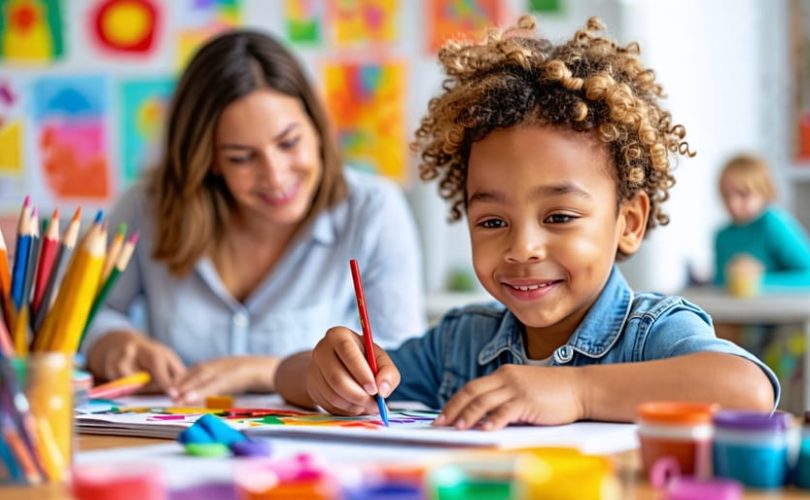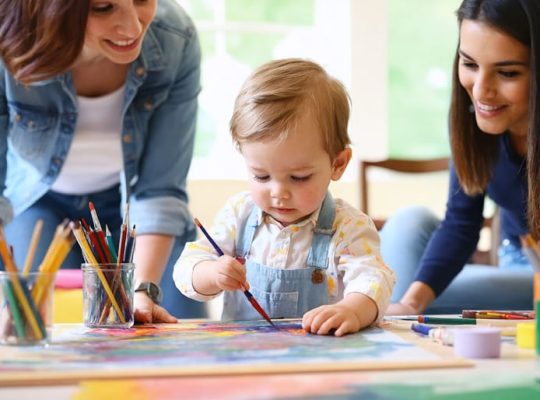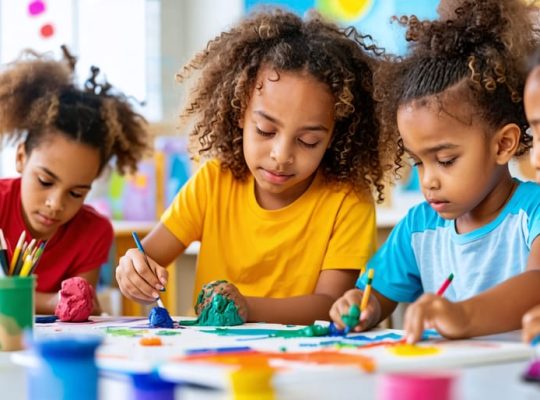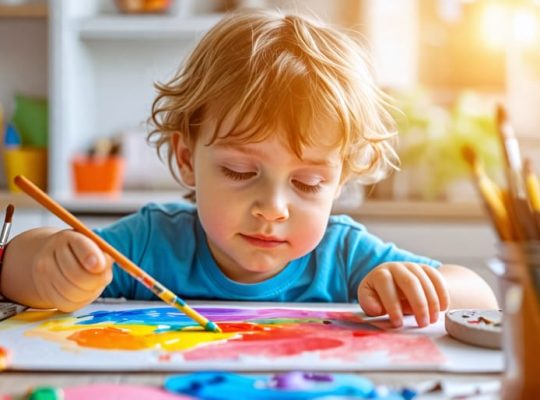Encourage self-expression by introducing simple art projects—drawing, painting, or clay modeling—allowing children to articulate feelings that might be difficult to express verbally. Incorporate themes like emotions or family to help children explore their thoughts and feelings in a safe, enjoyable way. Consult with an art therapist to design age-appropriate activities that align with individual needs, ensuring a supportive environment that fosters emotional growth. Observe and discuss the art creations with the child, providing empathetic feedback and encouraging storytelling about their artwork to enhance understanding and emotional processing.
Understanding Art Therapy
The Origins and Growth of Art Therapy
Art therapy, now recognized worldwide as a powerful aid in mental health, traces its roots to the mid-20th century. Pioneers like British artist Adrian Hill first used art as a therapeutic tool while recovering from tuberculosis. His discovery of the calming and expressive power of creativity soon caught the attention of psychiatrists who saw its potential to help patients express emotions they couldn’t put into words. Over the decades, art therapy has evolved significantly, integrating both art and psychological principles to support patients’ emotional well-being.
In the 1940s and 50s, the practice gained further traction as mental health professionals recognized the value of creative self-expression, particularly for children. Art allowed them to communicate complex feelings without the pressure of verbal language—a breakthrough for many dealing with traumas or developmental challenges. Today, art therapy is celebrated not only for its effectiveness in helping children manage emotions and reduce stress but also as a practice encouraging personal growth and self-esteem. It’s heartening to witness how these creative interventions empower young minds to heal and flourish.
How Art Therapy Works
Art therapy serves as a gentle pathway for children to explore and express their emotions, especially when words fall short. Through engaging in creative art therapy, children can depict what they feel inside without judgment. This process helps them manage anxiety, sadness, and other complex emotions by transforming internal chaos into visible art. By creating art, children also develop problem-solving skills and self-confidence. Art therapists, trained in recognizing the symbolism in art, guide children through their creative journey, offering emotional support and insights that reinforce mental well-being, all within a safe, nurturing environment.
Benefits of Art Therapy for Children’s Mental Health
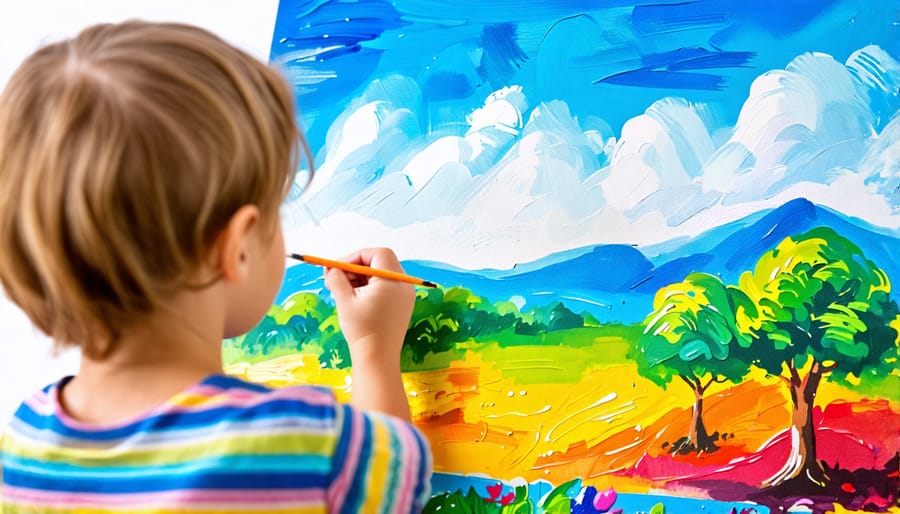
Emotional Expression and Stress Reduction
Art therapy offers a nurturing space where children can express emotions freely through creative activities, like drawing or painting, often conveying feelings they struggle to put into words. This form of expression not only provides relief from bottled-up emotions but also serves as a healthy outlet for stress. Imagine a child who feels overwhelmed by school pressures. Through art, they might depict these feelings in colors and shapes, transforming anxiety into something tangible and manageable. Art therapists collaborate with children to help them release and understand their emotions, reducing the burden of stress.
Consider Sarah, a young girl who struggled with anxiety after starting a new school. Regular art therapy sessions allowed her to explore her feelings creatively, helping her feel calmer and more in control. Experts emphasize that art therapy encourages emotional growth, gradually fostering resilience. By embracing artistic expression, children can navigate their complex emotional worlds with gentle guidance, lending them the tools to handle stress constructively.
Boosting Self-Esteem and Motivation
Creating art allows children to express themselves in unique and powerful ways, significantly boosting their self-esteem and motivation. When a child immerses in the creative process, they’re not only tapping into their innate abilities but also gaining a sense of accomplishment and pride in their creations. This feeling of achievement is a crucial building block for self-esteem. According to art therapist Jane Smith, “Art provides a safe space for children to experiment and succeed, fostering a belief in their capabilities.”
Moreover, art serves as a motivational tool, encouraging kids to set goals and persevere to complete their projects. Personal experiences shared by parents reveal that children often develop a greater sense of purpose and determination when engaged in art. For instance, young Ella discovered her passion for painting, which not only improved her mood but also inspired her to explore new techniques and ideas. Ultimately, art therapy becomes a joyful journey, empowering children to recognize and celebrate their talents, driving them towards a more confident and motivated self.
Enhancing Communication Skills
Art therapy offers a unique avenue for children, especially those who struggle with verbal communication, to express their thoughts, emotions, and experiences. By engaging in creative activities, such as drawing and painting, children can convey complex feelings they might find challenging to articulate with words. This form of expression not only serves as a release but also bridges the gap between their inner world and the external world. For instance, Sarah, a ten-year-old with social anxiety, found her voice through vibrant colors and abstract shapes, which helped her communicate her experiences more effectively. Experts agree that enhancing non-verbal communication through art therapy can significantly improve children’s overall communication skills. As they gain confidence in expressing themselves through art, children often find it easier to engage in verbal interactions. For more on how various influences affect children’s mental health, consider exploring this article on the impact of social media. Through the gentle guidance of certified art therapists, this creative outlet fosters a safe space where children can explore their emotions, leading to better understanding and communication with others.
Case Studies and Personal Stories
Meet Mia, a spirited 8-year-old who once struggled with expressing her feelings, often leading to frustration and withdrawal. Through art therapy sessions, Mia found her voice. She began painting bright scenes of nature, vividly depicting her emotions. For Mia, each brushstroke was a way to open up about her world, helping her communicate in a way that words never could. Guided by her art therapist, Mia’s progress became evident. Her mother noticed a calmer, more expressive Mia at home and attributes this to the nurturing environment provided by art therapy.
Then there’s Jack, a 10-year-old diagnosed with anxiety. Traditional therapy sessions seemed daunting to him, adding to his anxious feelings. However, Jack’s journey with art therapy brought a sense of relief. By creating clay models, Jack was able to channel his anxiety into a tactile experience that felt safe and manageable. His art therapist encouraged him to sculpt his worries, allowing Jack to externalize and then metaphorically reshape his concerns. This unique approach transformed Jack’s outlook, providing him with coping mechanisms that extended beyond the therapy room.
These personal stories highlight how art therapy can make an impactful difference in children’s lives. Not only does it provide a creative outlet, but it also serves as a bridge to understanding emotional complexities. Experts in child psychology agree that art therapy offers a non-threatening way for young ones to explore their feelings. By engaging in artistic expression, children like Mia and Jack find empowerment and a means to process their emotions constructively.
For parents, teachers, and healthcare professionals interested in supporting child mental health, art therapy proves to be a promising avenue. Understanding these success stories can inspire more caregivers to consider art therapy as a valuable tool, fostering resilience and emotional growth in children.
Expert Opinions on Art Therapy
Art therapy has emerged as a powerful tool in the realm of mental health treatment, especially for children. Many experts, including child psychologists and art therapists, advocate for its unique ability to help children express emotions that they might find difficult to verbalize. Dr. Laura Evans, a renowned child psychologist, emphasizes that art therapy allows children to engage their creativity while subtly working through emotional challenges. She notes that the use of art as a therapeutic tool can foster self-awareness and self-esteem in young individuals.
Art therapists like Mark Thompson highlight how art provides a safe space for children to explore their thoughts and feelings without the pressure of finding the right words. He explains that when children engage in creating art, it gives them an opportunity to reflect on their experiences and communicate their inner world through colors, shapes, and textures.
Research in this field also points towards art therapy’s effectiveness in reducing anxiety and stress, contributing to overall emotional well-being. These findings reinforce what experts have observed in practice: art serves as a bridge between the internal and external worlds of children, helping them process complex feelings in a tangible way. As art therapy continues to gain recognition, mental health professionals are hopeful about its expanding role in supporting children’s mental health.
For parents and teachers, understanding the benefits of art therapy and incorporating it as a complementary approach to other interventions not only offers a creative outlet but also a pathway to fostering healthier emotional development in children.
Integrating Art Therapy Into Your Child’s Routine
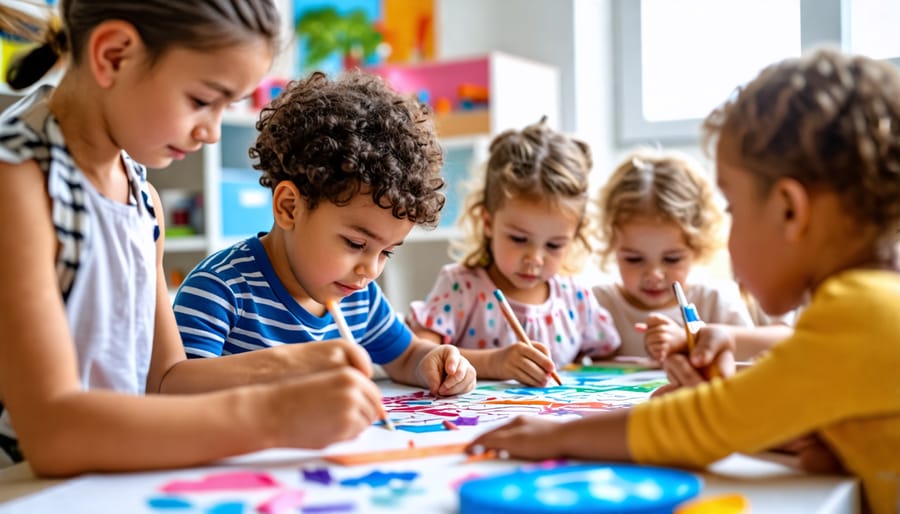
Simple Art Therapy Activities for Home and School
Art therapy offers a creative outlet that can play a vital role in nurturing mental well-being. By engaging in simple art activities, children express themselves and process emotions in a safe space. A few easy projects can be seamlessly integrated at home or in the classroom. Start with what you have; coloring books or blank paper with crayons offer children a chance to let their imagination flow. Encourage drawing emotions by asking them to create a picture of how they feel today—this can open pathways for communication.
For those inspired by nature, collect leaves or flowers and create a collage. This not only strengthens fine motor skills but also teaches appreciation for the environment. And don’t forget the power of storytelling! Have children illustrate a story they’ve imagined or an event they enjoyed. Sharing this can boost confidence and social skills. Simple and welcoming, these activities are perfect for fostering emotional growth and resilience in children. For more inspiration, explore various strategies for nurturing mental well-being.
Choosing the Right Art Therapist
Finding the right art therapist for your child involves considering several important factors to ensure a supportive and effective experience. Start by looking for a certified or registered art therapist who has specific training and experience working with children. It’s often helpful to ask for recommendations from healthcare professionals or other parents. During the initial meeting, observe how the therapist interacts with your child and whether they create a comfortable and welcoming environment. An empathetic approach is essential to help your child open up and express themselves freely. Trust your instincts to choose someone who feels like the right fit for your family’s needs.
In summary, art therapy offers a compassionate and creative way for children to express their emotions and enhance their mental health. By engaging with various forms of artistic expression, children can reveal feelings that might be too complex to articulate with words, making it a powerful tool for therapeutic healing. Experts agree that this approach not only helps in identifying and managing mental health concerns early on but also promotes emotional resilience and self-esteem. Stories from parents and educators highlight how art therapy has transformed anxiety and stress into creativity and communication, providing children with a safe haven to explore their thoughts. Whether through drawing, painting, or sculpting, art therapy creates a non-judgmental space where children can flourish. Embracing this form of therapy can be a pivotal step towards nurturing a child’s emotional well-being. It encourages caregivers and professionals to look beyond traditional methods and embrace the healing potential of art as a supportive tool in a child’s life.

